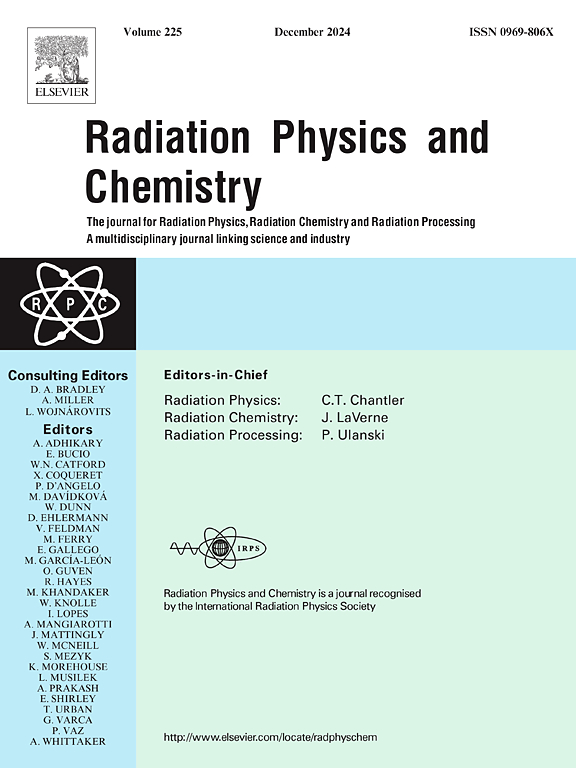扫描方式对Halcyon直线加速器相对电子密度- ct数校准和放疗剂量计算的影响
IF 2.8
3区 物理与天体物理
Q3 CHEMISTRY, PHYSICAL
引用次数: 0
摘要
组织相对电子密度(RED)通常通过计算基于CT的Hounsfield单位(HU)值来确定,其准确性受CT扫描参数选择的影响。这些对RED-CT数值校准曲线的影响是重要的,尤其是对CT x射线管电压和电流的变化。本研究旨在探讨CT x射线管电压和电流的变化对RED - CT数转换校准曲线的影响,以提高放疗治疗计划中剂量计算的准确性。在200 mAs下,在80,110和130 kVp的管电压下进行了电子密度幻象CIRS,并根据RED-CT数转换曲线校准了相应的图像。根据施加的管电压确定了后续处理计划,130 kVp计划被指定为参考计划。通过对等剂量分布和剂量的分析,将其余方案与参考方案进行了比较。与低密度材料相比,管电压对骨骼等高密度物质的影响最大。相反,无论选择管电压还是管电流,钛棒的CT数都是一致的。在较高的管电压下,管电流变化对校准曲线的影响较小,但在较低的电压和电流下,管电流变化对校准曲线的影响更为明显。高密度材料的桥塞模体中存在梁硬化伪影,影响其他桥塞的RED值。为了实现放射治疗计划的精确剂量计算,这项工作强调需要考虑CT扫描参数对RED-CT数转换曲线的影响。进一步强调的是仔细选择成像方案的重要性,以尽量减少光束硬化伪影,并确保准确确定RED。研究表明,高密度材料的存在极大地影响了RED- ct数转换曲线的准确性,高密度材料会导致光束硬化伪影,从而影响其他桥塞的RED值精度。本文章由计算机程序翻译,如有差异,请以英文原文为准。
Scanning protocol influence on relative electron Density-CT number calibrations and radiotherapy dose calculation for a Halcyon Linac
Tissue Relative Electron Density (RED), typically determined via computation of CT-based Hounsfield unit (HU) values, has an accuracy which is affected by the choice of CT scanning parameters. The influence of these on the RED-CT number calibration curves is of importance, not least concerning variations in CT x-ray tube voltage and current. The purpose of this study was to examine the effect of variations in CT x-ray tube voltage and current on the calibration curves of RED - CT number conversion, with the aim of improving the accuracy of dose calculation in radiotherapy treatment planning. An electron density phantom CIRS have been conducted at 200 mAs, for tube voltages of 80, 110, and 130 kVp, corresponding images being calibrated in terms of RED-CT number conversion curves. Subsequent treatment plans have been generated, identified in terms of the applied tube voltages, the 130 kVp plan being designated the reference plan. The remaining plans have been compared to the reference plan via analysis of isodose distribution and dose. The influence of tube voltage were being found to be greatest for high-density substances such as bone in comparison to low-density materials. Conversely, the CT number of a titanium rod has been consistent, regardless of the choice of tube voltage or current. The effect of tube current variation on the calibration curves has been minor at higher tube voltages but more pronounced using lower voltages and current. The presence in the phantom of plugs of high-density materials has resulted in beam hardening artefacts, impacting on the RED values for other plugs. In achieving accurate dose calculation for radiotherapy treatment plans the work underscores the need to account for effects of CT scanning parameters on the RED-CT number conversion curves. Further emphasized is the importance of careful selection of imaging protocols in seeking to minimize beam hardening artefacts and to ensure accurate determination of RED. The study demonstrates that the accuracy of RED-CT number conversion curves is substantially affected by the presence of high-density materials in the phantom, which causes beam hardening artefacts that affect the precision of RED values for other plugs.
求助全文
通过发布文献求助,成功后即可免费获取论文全文。
去求助
来源期刊

Radiation Physics and Chemistry
化学-核科学技术
CiteScore
5.60
自引率
17.20%
发文量
574
审稿时长
12 weeks
期刊介绍:
Radiation Physics and Chemistry is a multidisciplinary journal that provides a medium for publication of substantial and original papers, reviews, and short communications which focus on research and developments involving ionizing radiation in radiation physics, radiation chemistry and radiation processing.
The journal aims to publish papers with significance to an international audience, containing substantial novelty and scientific impact. The Editors reserve the rights to reject, with or without external review, papers that do not meet these criteria. This could include papers that are very similar to previous publications, only with changed target substrates, employed materials, analyzed sites and experimental methods, report results without presenting new insights and/or hypothesis testing, or do not focus on the radiation effects.
 求助内容:
求助内容: 应助结果提醒方式:
应助结果提醒方式:


